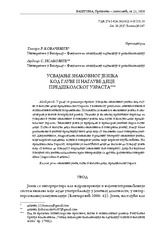Приказ основних података о документу
Usvajanje znakovnog jezika kod gluve i nagluve dece predškolskog uzrasta
Adoption of the sign language with deaf and hard of hearing preschool children
| dc.creator | Kovačević, Tamara | |
| dc.creator | Isaković, Ljubica | |
| dc.date.accessioned | 2021-06-09T14:32:28Z | |
| dc.date.available | 2021-06-09T14:32:28Z | |
| dc.date.issued | 2020 | |
| dc.identifier.issn | 0353-9008 | |
| dc.identifier.uri | http://rfasper.fasper.bg.ac.rs/handle/123456789/1276 | |
| dc.description.abstract | This study analyses the process of adopting of the sign language with deaf and hard of hearing preschool children in the context of the result of linguistic and psycholinguistic research. The importance of the sign language is emphasized and its historical development is analyzed. It is pointed to the significance of the critical period for the adoption and the learning of the sign and spoken language with deaf and hard of hearing preschool children. The sign language is natural and primary linguistic expression of deaf children. Deaf and hard of hearing children are exposed to the sign and spoken language, they have better understanding and linguistic production than the children who are only exposed to the spoken language. Bilingualism involves the knowledge and the regular use of the sign language, which is used by the deaf community, and of the spoken language, which is used by the hearing majority. Children at the preschool age should be enabled to continue to adopt the language they started to adopt within the family (the sign language or the spoken language). Children will adopt the best both linguistic modalities through the interaction with other fluent speakers (the adults and children). | en |
| dc.description.abstract | U radu se razmatra proces usvajanja znakovnog jezika kod gluve i nagluve dece predškolskog uzrasta u kontekstu rezultata lingvističkih i psiholingvističkih istraživanja. Istaknuta je važnost znakovnog jezika i analiziran je njegov istorijski razvoj. Ukazano je na značaj kritičnog perioda za usvajanje i učenje znakovnog i govornog jezika kod gluve i nagluve dece predškolskog uzrasta. Znakovni jezik je prirodan i primaran jezički izraz gluve dece. Gluva i nagluva deca izložena znakovnom i govornom jeziku, imaju bolje razumevanje i jezičku produkciju nego deca koja su izložena samo govornom jeziku. Dvojezičnost, podrazumeva poznavanje i redovnu upotrebu znakovnog jezika, koji koristi zajednica gluvih i govornog jezika koji koristi čujuća većina. Na predškolskom uzrastu, potrebno je omogućiti deci da nastave da usvajaju jezik koja su počela da usvajaju u porodici (znakovni ili govorni). Deca će najbolje usvojiti oba jezička modaliteta kroz interakcije sa drugim fluentnim govornicima (odraslima i decom). | sr |
| dc.publisher | Institut za srpsku kulturu Priština, Leposavić | |
| dc.relation | info:eu-repo/grantAgreement/MESTD/Basic Research (BR or ON)/179055/RS// | |
| dc.rights | openAccess | |
| dc.rights.uri | https://creativecommons.org/licenses/by/4.0/ | |
| dc.source | Baština | |
| dc.subject | sign language | en |
| dc.subject | deaf and hard of hearing children | en |
| dc.subject | preschool age | en |
| dc.subject | znakovni jezik | sr |
| dc.subject | gluva i nagluva deca | sr |
| dc.subject | predškolski uzrast | sr |
| dc.title | Usvajanje znakovnog jezika kod gluve i nagluve dece predškolskog uzrasta | en |
| dc.title | Adoption of the sign language with deaf and hard of hearing preschool children | sr |
| dc.type | article | |
| dc.rights.license | BY | |
| dc.citation.epage | 535 | |
| dc.citation.issue | 51 | |
| dc.citation.other | (51): 513-535 | |
| dc.citation.rank | M51 | |
| dc.citation.spage | 513 | |
| dc.identifier.doi | 10.5937/bastina30-267 | |
| dc.identifier.fulltext | http://rfasper.fasper.bg.ac.rs/bitstream/id/241/1273.pdf | |
| dc.type.version | publishedVersion |


